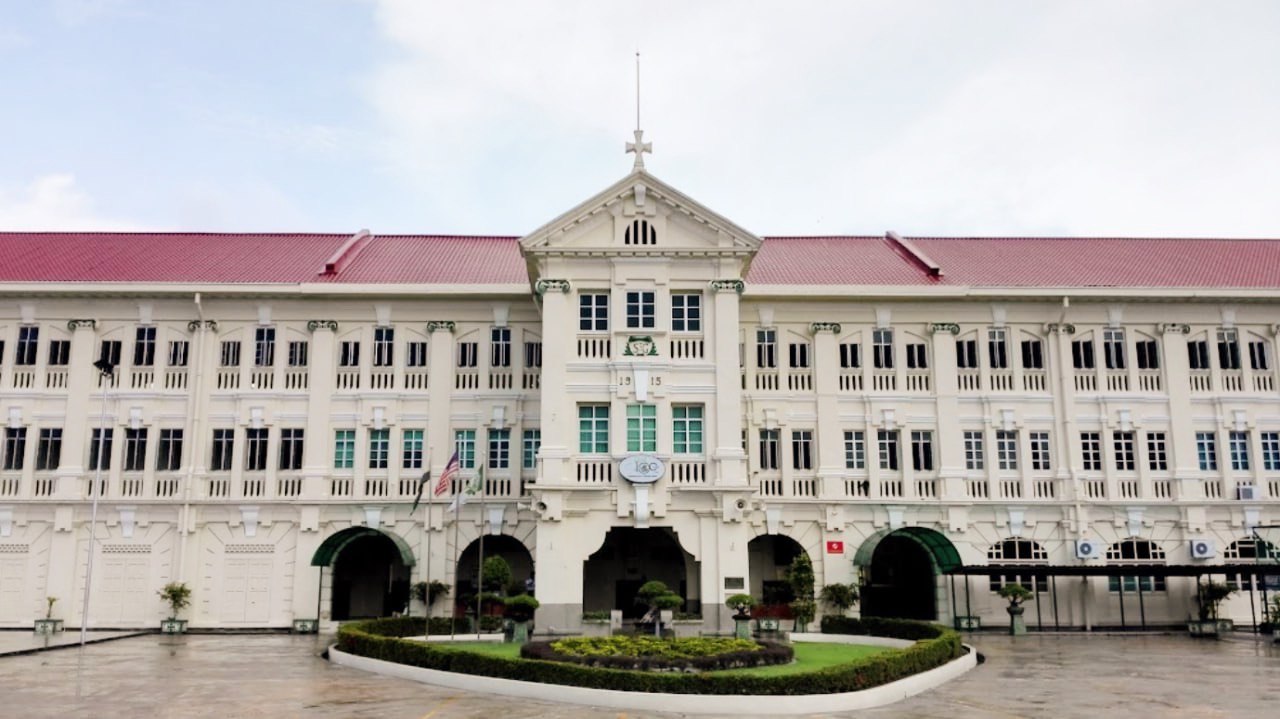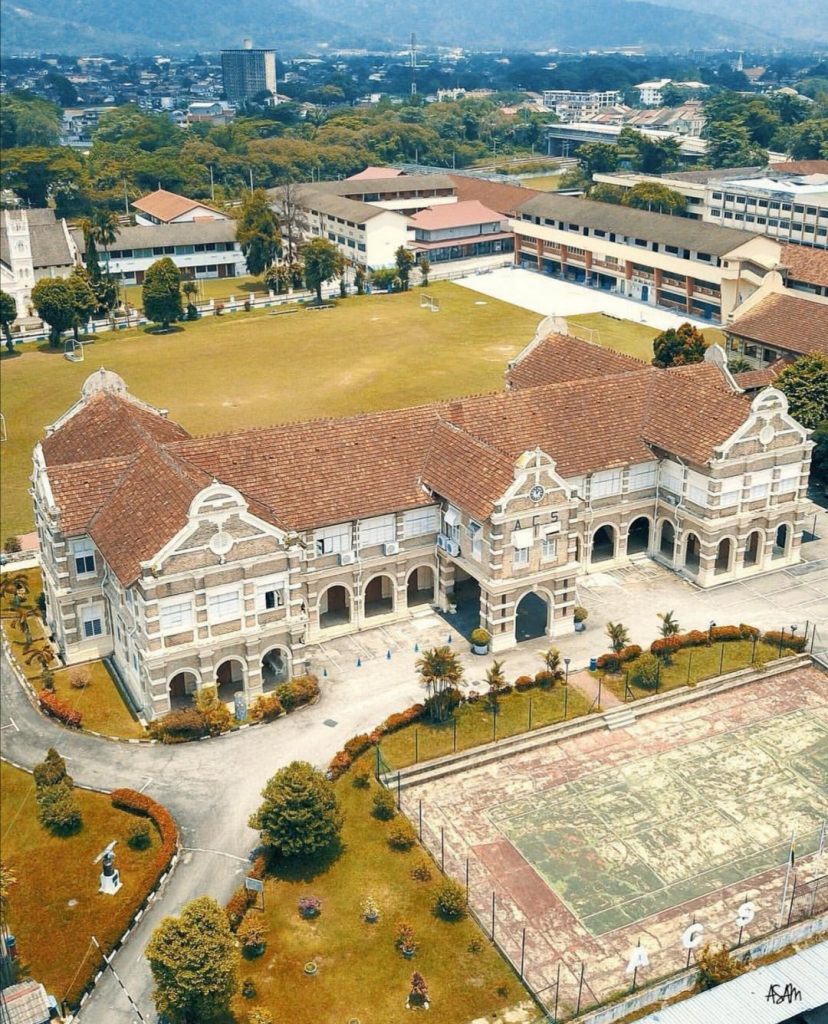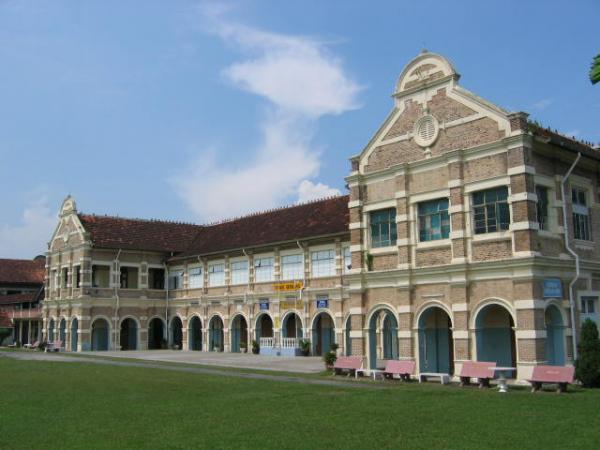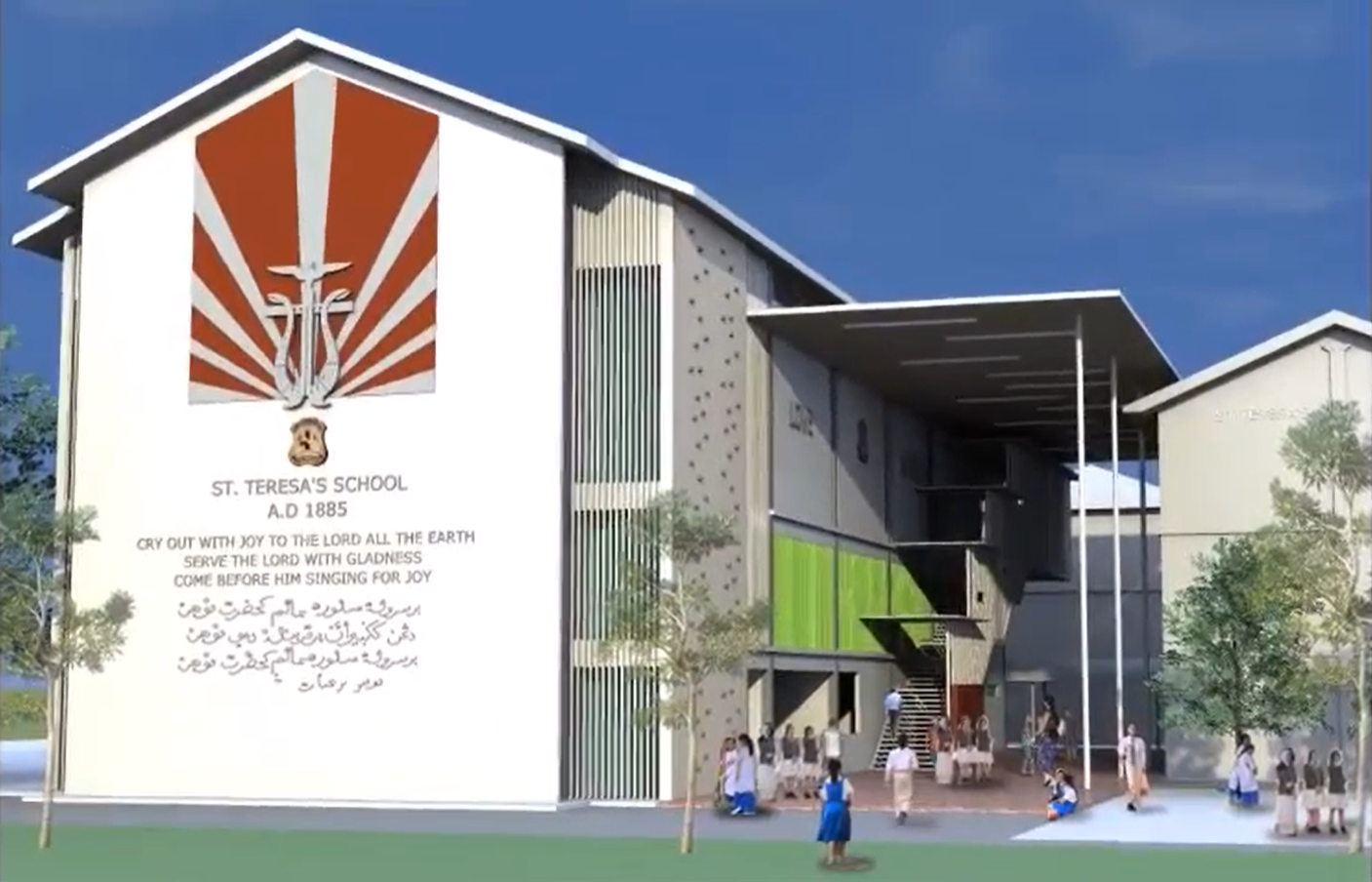Colonial school buildings in Malaysia
Colonial architecture is one of the most unique and valuable features of Malaysia. They are priceless testaments to the history of our country, and treasures from the British administration era that have survived through wars.
In the effort to modernise our urban landscapes post-independence, older buildings have given away to more sophisticated architecture – such as our iconic Petronas Twin Towers. But a handful of structures have managed to dodge the grasp of redevelopment or demolishment plans – most notably, schools in Malaysia.
We rounded up a list of 17 schools in Malaysia that are older than the country itself and housed in colonial buildings.
Table of Contents
- Colonial school buildings in Malaysia
- 1. Penang Free School, Penang – oldest English school in Malaysia
- 2. St. Michael’s Institution, Perak – a Japanese operation centre during WWII
- 3. SK Convent Tanah Rata, Pahang – a red-brick gothic beauty that was briefly a hospital
- 4. St. Thomas’ Secondary School, Sarawak – the state’s first school
- 5. Malay College Kuala Kangsar, Perak – alma mater to Malaysia’s former Prime Minister
- 6. St. George’s Institution, Perak – school of the Lasallian Brothers
- 7. Convent Light Street, Penang – once a boarding school for orphans
- 8. St. John’s Institution, Kuala Lumpur – a grand red-and-white brick building in the heart of KL
- 9. Anglo-Chinese School Ipoh, Perak – century-old school with four entries in the Malaysian Book of Records
- 10. Victoria Institution, Kuala Lumpur – a majestic clock tower mounted over the school’s pavilions
- 11. King Edward VII School, Perak – an award-winning rugby team
- 12. Maxwell School, Kuala Lumpur – a gazetted National Heritage
- 13. Main Convent, Perak – Michelle Yeoh’s alma mater
- 14. Clifford National School, Perak – oldest school in the state
- 15. Sacred Heart Canossian Convent, Melaka – a school for orphans and the Portuguese community
- 16. King George V School, Seremban – 100th anniversary this year
- 17. St. Teresa’s National Secondary School – started in England
- Colonial school buildings that are as old as Malaysia
1. Penang Free School, Penang – oldest English school in Malaysia

Image credit: MAHMUD IZUDDIN via Google Photos
The oldest English-medium school in Malaysia, Penang Free School (PFS) has been educating students for a whopping 206 years. Established in 1816, PFS was the first English school in the country, founded by Reverend Robert Sparke Hutchings.
It was originally opened to cater to the children of European and Government Officials. However, once Hutchings realised there was a lack of education for the general public, he petitioned for it to be a “free school” that welcomed all children regardless of their race or religion.

Image credit: Ng Seah Wooi via Google Photos
Its first building was at Farquhar Street. But after the premise reached its maximum capacity due to the ever-growing enrolment of students, Penang Free School relocated to Green Lane – where it remains to this day.
2. St. Michael’s Institution, Perak – a Japanese operation centre during WWII

Image credit: Wahyu Handoko via Google Photos
Founded by Reverend Father J.B. Coppin in 1912, St. Michael’s Institution started on a humble plot of land in Kampung Pisang. A bungalow on Clayton Road serves as it the main school building, with a well beside it for the students’ convenience.
As more students enrolled in the institution, the Lasallian Brothers took over the school and expansion plans were executed. The new buildings, designed by Brother Vernier Augustus, feature an ornate and distinctive European architectural style.

Image credit: @stmichaelsinstitution via Instagram
During World War II, St. Michael’s Institution was closed and used as a headquarter for the Japanese government to carry out their operations in the area. When the Japanese surrendered, the school was reopened and passed through the hands of several directors, who each contributed to the expansion of the school building.
Today, the school has four halls, two football fields, several sports courts, and numerous workshops and labs, as well as a lecture theatre, canteen, foyer, chapel, pavilion and the Marian Library. There is also a private gallery – called the Heritage Room – that stores old antiques, trophies and other unique items on the topmost floor of the school.
3. SK Convent Tanah Rata, Pahang – a red-brick gothic beauty that was briefly a hospital

Image credit: Akihito Morita via Google Photos
Cameron Highlands is one of Malaysia’s most popular scenic spots, with its extensive hills and many buildings entwined with stories of the past. Standing elegantly in Tanah Rata is SK Convent Tanah Rata – or simply SK Convent Cameron Highlands – a national primary school in a regal English-style building, in tune with the colonial era charms that Cameron Highlands is also famed for.
When it first opened in 1935, SK Convent Tanah Rata was a boarding school for the expatriate community. The gothic-style building was designed by Mr P.L.M. Bathan, and went by the name of Pensionnat Notre Dame.

Image credit: williewonker via Flickr
Though student enrolment grew steadily over the years, World War II forced the school to close, and its building was converted into a hospital by the Japanese army. The school continued its operations post-war, but only within huts scattered around the compound as the main building was taken over by the British Army Hospital.
In 1971, the building was handed over to the congregation of SK Convent and restored to school-appropriate condition. SK Convent remains as a primary school till this day, and a stylish landmark of Cameron Highlands.
4. St. Thomas’ Secondary School, Sarawak – the state’s first school

Image credit: Luke Smith via Google Photos
St. Thomas’ Secondary School was founded by priest cum doctor Francis Thomas McDougall in 1848, when Rajah James Brooke requested the missionary to adopt four Eurasian children. The school in Kuching, Sarawak, was separated and segregated by gender – St. Thomas for boys, and St. Mary for girls.
As with the fate of many schools during the Japanese occupation, St. Thomas was seized by the Japanese army in 1941 and used as their military camp and headquarters. After years of war, the school building was left wrecked.
Following the war, the institution was restored and expanded dramatically, and eventually became a government-aided school.

Image credit: Luke Smith via Google Photos
However, in 1979 – and again in 1989 – a horrific blaze broke out in the school’s main building, consuming many of the essential facilities, offices and school records.
The building was successfully repaired with raised funds. Today, St. Thomas boasts architecture that’s a refreshing mix of old and new, and is regarded as an elite institution.
5. Malay College Kuala Kangsar, Perak – alma mater to Malaysia’s former Prime Minister

Image credit: @c_honloong via Instagram
Along Jalan Tun Razak in Kuala Kangsar, an extensive lush green field catches the eyes of pedestrians – on it stands the Neoclassical British campus of Malay College Kuala Kangsar (MCKK).
It opened in 1905 as Malaysia’s first fully residential school, by RJ Wilkinson who was the inspector of schools for the Federated Malay States. The Malay Residential School – its original name – was built to educate the upper echelons of the Malay community, namely sons of royal families and young boys of nobility.
But this changed when Tun Abdul Razak Hussein – the Malaysian Minister of Education at that time – amended the enrolment requirements to be more inclusive. Hence, selected individuals, aged between 12 to 17, could now attend the academy, no matter their background.

Image credit: @mckk_official via Instagram
The vast college ground holds three fields and spaces for the students’ physical activities, making MCKK distinguished for its sports – rugby, in particular.
The institution grew to become a pride of Perak, shaping many recognisable political figures such as Tun Abdul Razak, Anwar Ibrahim, Hishammuddin Hussein and Rafizi Ramli – to name a few. It gained a High Performing School title due to its good reputation in the field of education.

Image credit: Azri Adnan via Google Photos
As the institution grew academically, its building expanded considerably as well. Its breathtaking classical revival portico often leaves passers-by gawking in awe.
6. St. George’s Institution, Perak – school of the Lasallian Brothers

Image adapted from: Bernard C via Google Photos
The grand south facade of St. George’s Institution (SGI) in Taiping, Perak, beckons to all who pass by with its architecture, a stunning blend of Neo-Grec and Neo-Romanesque styles.
The school was designed by an ambitious colonial architect from Penang, and its perimeter is marked by four main roads – Station Road in the front, Barrack Road behind, and Cross Street No.9 and Cross Street No.10 on the left and right respectively.
SGI was founded in 1915 by the De La Salle Brothers – also called the Lasallian Brothers – and was principally a Catholic boys’ school. But it also welcomed students of all religions, races and social classes.
The 3-storey institution started out with only seven teachers and 49 students, and 6 classrooms and two main wings – one of the wings held the Brothers’ quarters.

Image credit: azli umar via Google Photos
When World War II hit, the Japanese army used the building as a headquarter for the Kempeitai – a secret Japanese military police force. This evoked rumours of the school being a Japanese torture house once, and naturally led to supposed ghostly sightings around the building.
The Lasallian Brothers always had a good rapport with its students, as their goal was to foster strong brotherhood ties among the school community. The traditional camaraderie within the school is still evident today.
7. Convent Light Street, Penang – once a boarding school for orphans

Image credit: Goon Hoong Tatt via Google Photos
Penang’s Convent Light Street (CLS) is said to be the oldest all-girls school in Southeast Asia, and pioneered the importance of female education on the island. Occupying the western end of Light Street and at the core of George Town UNESCO’s heritage site, the school was founded in 1852 by three strong-minded French Catholic nuns.
The nuns bought over the lavish Government House – which was once the home of Captain Francis Light – after their humble attap hut became overcrowded due to the growing number of students.
Big-hearted as they are, the nuns took in orphans of every age and race, and were fiercely devoted to providing students with education and a home. Before long, royal and wealthy families from neighbouring countries were sending their children to the boarding school as well.

Image credit: Amanda Goh via Google Photos
Convent Light Street was used as an interrogation centre when the Japanese army occupied the island. The school continued its educational operations after the Malayan independence. Though, student boarding ceased following the standardisation Malaysian education system.
Today, Convent Light Street is an exemplary institution for girls, and a notable heritage building with historical relics and monuments scattered throughout its compound, each holding its own story of the institution’s past.
8. St. John’s Institution, Kuala Lumpur – a grand red-and-white brick building in the heart of KL

Image credit: Cheexin Ng via Google Photos
St John’s Institution is a grandiose red-and-white brick superstructure in Bukit Nanas, built in the Grecian-Spanish style.
The 118-year-old institution was just a modest 2-storey wooden house when the Lasallian Brothers first enrolled 18 boys at the school in 1904. Only in 1921, Brother Stephen Edward Buckley oversaw renovations of the school’s building to its present-day facade.
Nearly every director of the institution played a part in expanding the school structure or establishing a monument – most notably, the gorgeous Jean-Baptiste De La Salle statue perched on the central balcony.

Image credit: The Rat Man via Flickr
During the Japanese occupation, then-director Brother Cornelius compassionately allowed refugees to take shelter in the school. To pay him back for his kind deed, the refugees contributed to a scholarship fund after the war.
Given its age and spectacular architecture, St. John’s Institution was gazetted as a Heritage Site by the Malaysian Ministry of Culture, Arts and Heritage in 2010.

Image credit: Fitri Hakeem via Google Photos
9. Anglo-Chinese School Ipoh, Perak – century-old school with four entries in the Malaysian Book of Records

Image credit: @ipoh_lover (aimannsyahin) via Instagram
Picturesque and grand, Anglo-Chinese School Ipoh is an esteemed school that is attended by the cream of the crop.
Englishman Reverend William Edward Horley started the school in a rented house, after the institution’s previous building was demolished to make way for a mosque. The new building had distinct shutters painted rich blue and yellow, which inspired the school’s official colours of blue and gold.

Image credit: Visit Perak
Reverend Horley’s diary entries were significant in recounting the school’s history. Founded in 1895, ACS Ipoh is one of his proudest creations. It developed rapidly since it was established, and now has a swimming pool, a badminton court, a huge library, two Methodist churches, and extensive fields for various sports.
Showing their school spirit, the school community even made it to the Malaysian Book of Records in 2007 for achieving the largest “Malaysian flag Kolam” with the help of over 2,000 students and 100 teachers. Two years later, it earned another place in the book for the largest aluminum structure made from recycled cans.
In 2013, the school achieved yet another feat – creating Malaysia’s largest plant mosaic using 31,000 plants. Their latest entry was in October 2022 with the completion of the Brick-a-thon, where the school gathered to build a massive canvas consisting of 93,000 bricks.
10. Victoria Institution, Kuala Lumpur – a majestic clock tower mounted over the school’s pavilions

Image credit: @chc79 via Flickr
Poised along Jalan Hang Tuah, Victoria Institution is a secondary and memorial school that possesses a medieval-esque allure with its iconic clock tower that’s as beautiful as it is intricate. With yellow-flame and palm trees hugging the institution’s circumference, the school paints a vivid tapestry of colonial-era history.
From humble grounds, Victoria Institution – which commemorates the Golden Jubilee of Queen Victoria – was originally erected at Jalan Tun H.S. Lee in 1893 by Lady Treacher. Several citizens saw the need for a solid English school in the country following the success of Raffles institution in Singapore, hence the Victoria Institution’s construction.
However, due to constant flooding in the city, the school shifted to its current location.

Image credit: @chc79 via Flickr
Today, it is one of the nation’s most prestigious secondary schools for boys and girls in Form 6, excelling in academics, sports and many other extracurricular activities.
11. King Edward VII School, Perak – an award-winning rugby team

Image credit: @WeeKit Ong via Flickr
King Edward VII School is a stunning red-and-white beauty that stands by Station Road – where Malaysia’s first railway station was built. The colonial building resembles a renaissance mansion, extravagant amidst a large field and trees.
Central School – its founding name – opened in 1883 in a small building where the Nurses’ Hostel currently stands. The burgeoning school later shifted to its present premise, and was given a new name in conjunction with King Edward’s coronation.
The school’s rugby team, who go by the Tigers, have made major milestones in the local rugby scene. The team was founded back in 1923, and has grown to become powerful rivals of top Malaysian rugby teams with their steadfast and ambitious spirit.
Sadly, the main building was forced to close due to serious termite infestation and lack of conservation efforts. But in true school spirit, present and former students banded together to carry out restoration works to the deteriorating building.
It has seen progress recently, with donations accepted to help restore their alma mater to its former glory.
12. Maxwell School, Kuala Lumpur – a gazetted National Heritage

Image credit: World Orgs
Granted National Heritage status in 2018, Maxwell School in Kuala Lumpur pays homage to Moorish-style architecture with its stucco and brick walls, decorative tiles and multiple horseshoe-shaped arches along the corridors.
The school has stayed at its original site for over a century now, ever since it was established in 1916. Named in honour of Sir William George Maxwell, Maxwell School’s building served multiple purposes. It was once a feeder school of Victoria Institution, a trade School, the Kempeitai base during the Japanese occupation and a technical college.

Maxwell School in 1954
Image credit: wikiwand
Today, it is an all-boys secondary school with additional facilities and an extended compound, with the colonial-Islamic influence still apparent in its architecture. Maxwell School excels in its sports and has bagged countless awards in various athletic fields. It is also well-known for having the oldest prefects board in Malaysia and Southeast Asia.
13. Main Convent, Perak – Michelle Yeoh’s alma mater

Image credit: CanadaGood Gregory via Flickr
Though visibly time-worn, Convent of Holy Infant Jesus – or more fondly known as Main Convent Ipoh – is a heritage all-girls secondary school with a Gothic Revival-inspired facade. Among the many symmetrical archways and windows with timber shutters that grace the 2-storey building, what stands out the most is a beautiful pointed arch that tops the main building, where a statue of Lord Jesus resides.

Image credit: Stinkee Beek via Flickr
When the school was founded by Mother St. Victoire in 1907, it was a mere wooden house with 20 students. Blocks and classrooms were added over the years as the school excelled academically, playing a leading role in female education since then.
Fun fact: Hollywood star and Ipoh-born Michelle Yeoh was enrolled at Main Convent Ipoh during her primary school days. The actress achieved stardom as the first Asian bond girl, and starred in many famous movies such as Crouching Tiger, Memoirs of a Geisha, Crazy Rich Asians and Shang-Chi.
14. Clifford National School, Perak – oldest school in the state

Image credit: zulkifli sulong via Google Photos
The recently refurbished Clifford National School in Kuala Kangsar, Perak, boasts a refreshing classy look, but still with a regal touch.
The history of Clifford National School dates back to 1897 when it was called Hogan School after its founder and first headmaster, Mr James Percival Charles Hogan. In 1928, the school was renamed after Sir Hugh Clifford, who was the Governor of the Straits Settlements and High Commissioner of Malaya at the time.
Though lessons were disrupted briefly during World War II, Clifford National School bounced back and rose to become a highly regarded school during the 1950s. To date, it is a premier boys’ school with many outstanding achievements, and is the oldest boys’ school in Perak.
15. Sacred Heart Canossian Convent, Melaka – a school for orphans and the Portuguese community

Image credit: Joo Seng Cheng via Google Photos
With a prominent statue of Lord Jesus in a brick red niche above its entrance, Sacred Heart Canossian Convent in Melaka is the first Canossian institution in Malaysia.
In 1905, four Canossian sisters occupied an old house in Bandar Hilir, Melaka, when the Portuguese Mission requested them to provide education for girls in need. Known as Portuguese Convent back then, the school welcomed orphans and boarders of both genders from mostly Portuguese families.
The school’s premise grew to accommodate new classes, chapels, a kindergarten, and eventually, extra buildings for the primary and secondary schools. At present, Sacred Heart operates a kindergarten and primary school at the Bandar Hilir premise, while a 4-storey school – SMK Canossa Convent – at the Portuguese Settlement admits secondary students.
16. King George V School, Seremban – 100th anniversary this year

Image credit: Sekolah Menengah Kebangsaan King George V via Facebook
Celebrating its 100th birthday this year, the King George V School building was initially a railway station that was then converted into a Government English School on 15th January 1923.
Characterised by a pristine white facade, the school’s main building stands grand along Hose Street ever since it was constructed in 1926. It was then named after King George V, who was the King of England ruling Malaya during the time the school opened.

Image credit: Wikimedia Commons
The white colonial structure holds its own history within. During the Japanese occupation of Malaya, the Japanese government invaded the school building, and made it the headquarters of their military police. Several rooms next to the school’s main hall were even used as torture rooms by the Japanese soldier.
When the British took over, the school served as a military hospital as well.
Now, King George V School is classified as a cluster school of excellence, offering a range of sports facilities with some of the most elite school sports teams in Malaysia.
17. St. Teresa’s National Secondary School – started in England

Image credit: Flickr
St. Teresa’s National Secondary School is an all-girls secondary school that had its humble beginnings at a small shop in Yorkshire Street in England before it moved to the lands of Sarawak.
Named in honour of a respected Carmelite sister, the school was launched in Borneo in the year 1885 upon the invitation of Rajah Charles Brooke to establish Catholic mission schools in Kuching.

Image credit: Rebuild SMK St Teresa Kuching
In an unfortunate twist of events, a major fire broke out in 2016 and the school’s Block A – which comprised the school hall, teachers’ rooms, and library – was completely razed down. The school underwent massive reconstruction after the incident, and the new building was completed in February 2021.
Colonial school buildings that are as old as Malaysia
The sheer number of colonial school buildings is a reminder of a notable era in our country’s history. Though Malaysia has developed tremendously over the years, the traces and echoes of the colonial era live on in the buildings – both aesthetically and culturally.
All in all, it is vital to continue the preservation of these irreplaceable buildings in our country, as they are pieces of heritage that testify to Malaysia’s storied history.
Fore more interesting buildings in Malaysia, read more about 10 abandoned heritage sites in Malaysia and 11 heritage buildings in KL with secret histories.
Cover image adapted from: Cheexin Ng via Google Photos, Luke Smith via Google Photos, @mckk_official via Instagram & Bernard C via Google Photos
This article was first published on 16th November 2022, and updated on 25th September 2023.
